目录
1聚合函数
1.1SQL类别高难度试卷得分的截断平均值

我的错误代码:截断平均值是有专门的函数吗?
select tag,difficulty,avg(score) clip_avg_score
from examination_info ei join exam_record
using(id)
group by tag
where tag = 'SQL' and difficulty='hard'
and score not in (max(score),min(score))我的思路改正:用 (全部值 - 最大值 - 最小值) / (总数-2) ,但是缺点就是,如果最大值和最小值有多个,这个方法就很难筛选出来
SELECT ei.tag,ei.difficulty,
ROUND((SUM(er.score)-MIN(er.score)-MAX(er.score)) / (COUNT(er.score)-2),1) AS clip_avg_score
FROM examination_info ei join exam_record er
on ei.exam_id = er.exam_id
where ei.tag = "SQL"
AND ei.difficulty = "hard";标准正确代码:
使用in子句将最大值和最小值排除掉,再求平均值
- 懒人写法,可以用with...as句式将要多次使用的表只写1次即可(WITH AS 语法是MySQL中的一种临时结果集,它可以在SELECT、INSERT、UPDATE或DELETE语句中使用。通过使用WITH AS语句,可以将一个查询的结果存储在一个临时表中,然后在后续的查询中引用这个临时表。这样可以简化复杂的查询,提高代码的可读性和可维护性。但是不知道哪个MySQL版本开始支持with...as句式的,我的本地电脑里面是Navicat 15 for MySQL,不支持)
- 用union把max和min的结果集中在一行当中,这样形成一列多行的效果,不用多写一次代码
# t1筛选出SQL高难度的数据
WITH t1 as(
SELECT er.*,ei.tag,ei.difficulty
FROM exam_record er INNER JOIN
examination_info ei
ON er.exam_id = ei.exam_id
WHERE tag = "SQL" and difficulty = "hard"
)
# 在t1的基础上计算均值
SELECT tag,difficulty,round(avg(score),1)
FROM t1
# 用in子句将最大值和最小值排除掉,再求平均值 not in
WHERE score not in (
SELECT max(score)
FROM t1
UNION
SELECT min(score)
FROM t1
)Q:为什么这里where换成and也不报错,因为前面有on?那么where和on有啥区别呢,可以只有一个吗?
A:
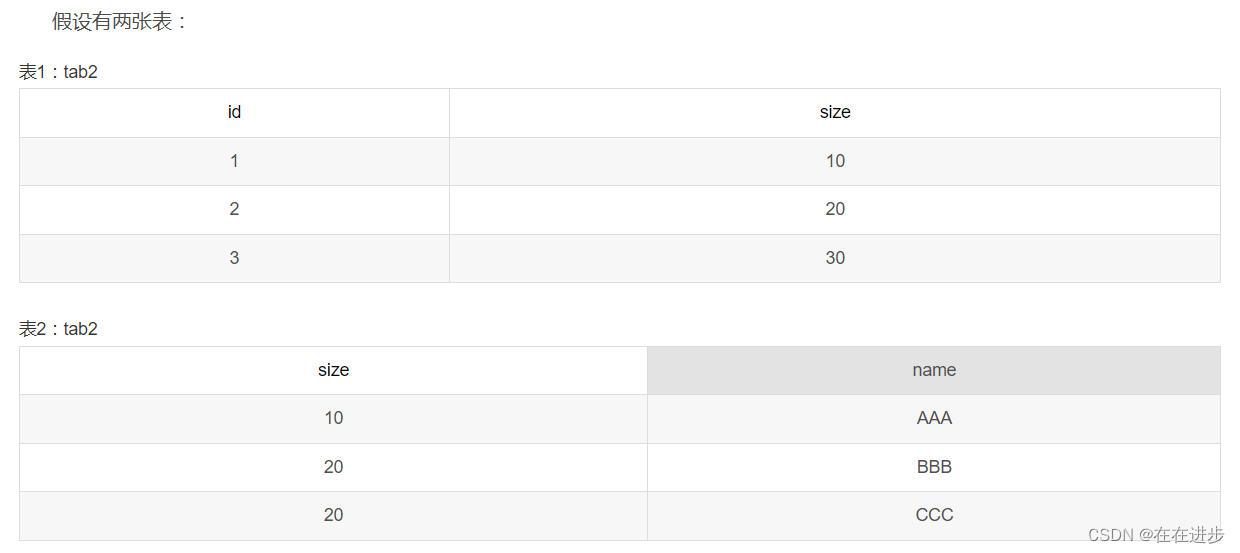
(1)where和having是在临时表生产之后,对临时表中的数据进行过滤用的。
如SQL语句:select * form tab1 left join tab2 on (tab1.size = tab2.size) where tab2.name=’AAA’
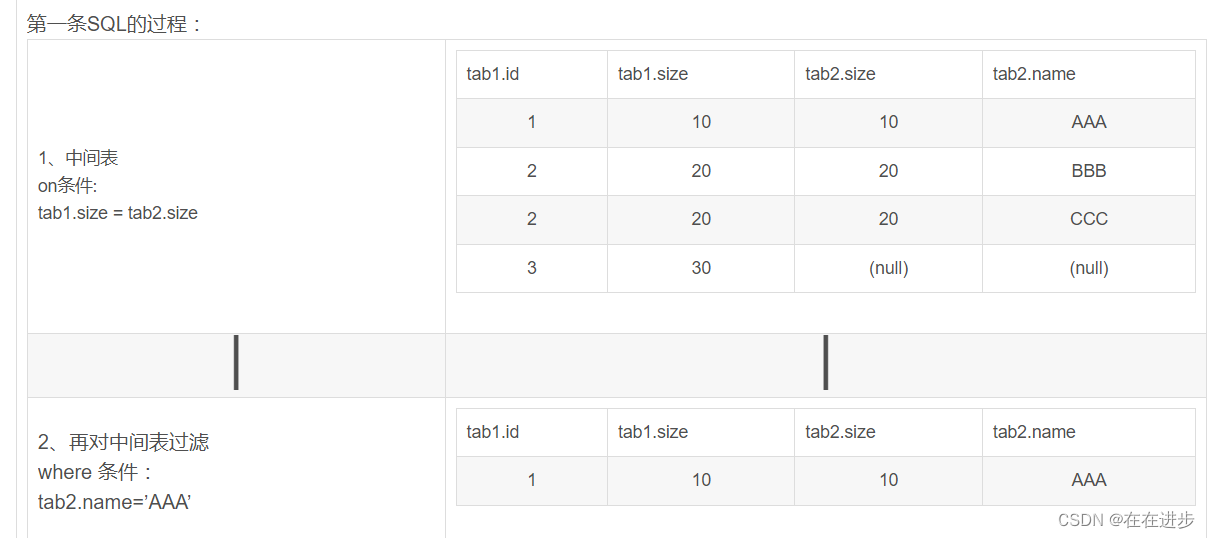
(2) on是在生成中临时表之前就去作用的,它会在数据源那里就把不符合要求的数据给过滤掉,即是先把不符合条件的记录过滤后才进行统计,它就可以减少中间运算要处理的数据所以on运行的速度最快。
如SQL语句:select * form tab1 left join tab2 on (tab1.size = tab2.size and tab2.name=’AAA’)

(3)在两个表联接时才用on的,所以在一个表的时候,就剩下where跟having比较了。在这单表查询统计的情况下,如果要过滤的条件没有涉及到要计算字段,那它们的结果是一样的,但是where可以使用rushmore技术,而having就不能,在速度上后者要慢。
(4) 如果要涉及到计算的字段,where的作用时间是在计算之前就完成的,而having就是在计算后才起作用的,所以在这种情况下,两者的结果会不同。
(5) 在多表联接查询时,on比where更早起作用。系统首先由on根据各个表之间的联接条件,把多个表合成一个临时表后,再由where进行过滤,然后再计算,计算完后再由having进行过滤。
1.2统计作答次数

我的报错代码:求已完成的试卷数时应该要分组一下,exam_id
select count(er.id) total_pv,
count(er.submit_time) complete_pv,
count(t2.exam_id) complete_exam_cnt
from exam_record er,(select count(exam_id) from exam_record
group by exam_id) t2正确代码1:
主要在于已完成的试卷数的统计,因为这个带有条件,且需要统计聚合结果,可以使用 聚合函数与case when 结合。count中是可以加条件的
select
count(*) total_pv,
count(score) complete_pv,
count(distinct case when score is null then null else exam_id end) complete_exam_cnt
from exam_record复习case when:
(1)case expr when v1 then r1 [when v2 then r2] ...[else rn] end
例如:case 2 when 1 then 'one' when 2 then 'two' else 'more' end 返回two
case后面的值为2,与第二条分支语句when后面的值相等相等,因此返回two
(2)case when v1 then r1 [when v2 then r2]...[else rn] end
例如:case when 1<0 then 'T' else 'F' end返回F
1<0的结果为false,因此函数返回值为else后面的F
正确代码2:
select count(*) as total_pv,
count(score) as complete_pv,
count(distinct exam_id,score IS NOT NULL or null) as complete_exam_cnt
# 是逗号,连接不是and连接
from exam_record在select和count后面都可以加条件的,但是要明白内核:
count(distinct exam_id,score IS NOT NULL or null) as complete_exam_cnt (正确)
不能是
count(distinct exam_id and score IS NOT NULL or null) as complete_exam_cnt (错误,结果永远为2, 这个题只是碰巧结果为2,改一个数据就不对了)
1 用and:
(1)一般在where后筛选过滤,还是得到的满足条件的score
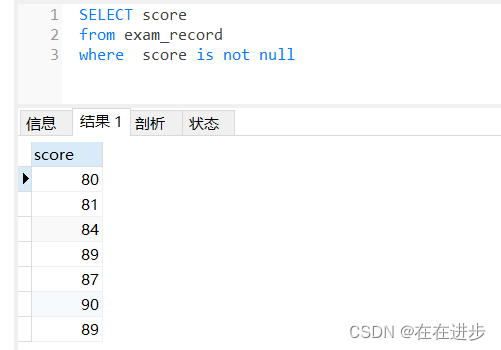
(2)如果在select后直接加条件判断:这里的score is not null 是判断
- 符合条件的返回 true ,即为1
- 不符合的返回 false ,即为0
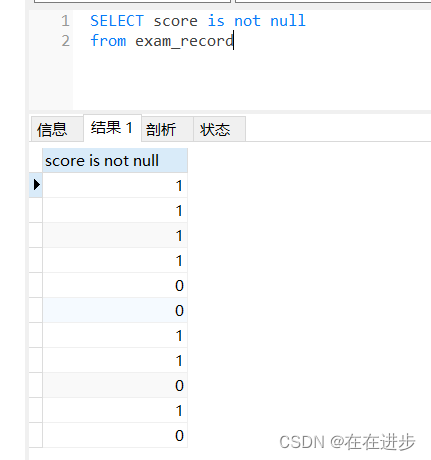
(3) 加上exam_id,进行and逻辑运算
- exam_id 本身为值,可以理解为真 在 and 逻辑下,所以上一步的1,0并不会变化,后面加上or NULL,否则会把0也计算上。
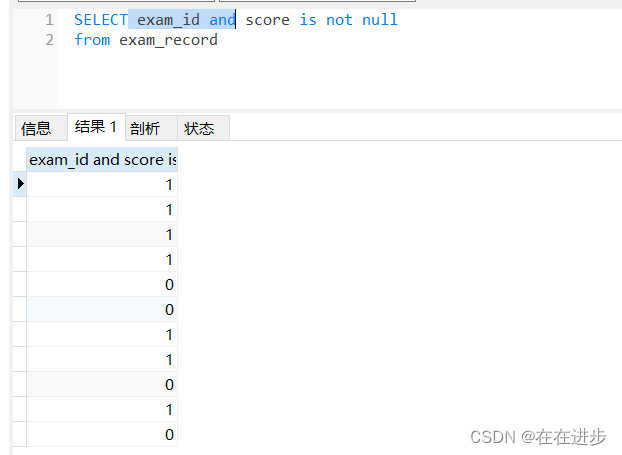
(4) 在上一步的基础上去重,则只会剩下1和0
- 经过and运算之后,只剩下一列数据,多行1和0
- distinct 去重后,就只剩下两行数据 1 和 0
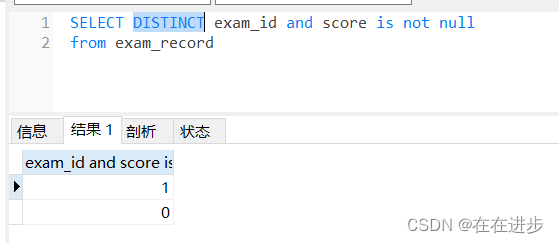
(5)所以这时候再进行count计算,结果恒为2 (两行数据)

2 正确答案的执行逻辑:
(1)用,连接(从之前的逻辑判断,变为多列组合)
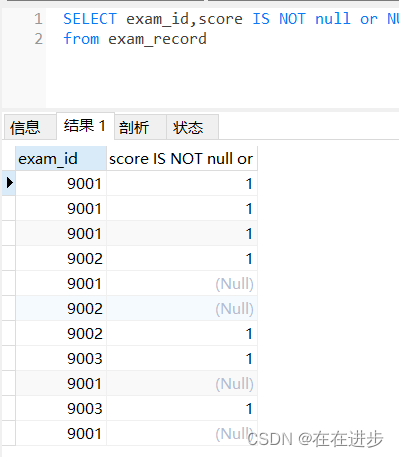
(2)这时候distinct 去重后,就不是只剩下两行数据 1 和 0,而是会把score为null也会考虑进去。
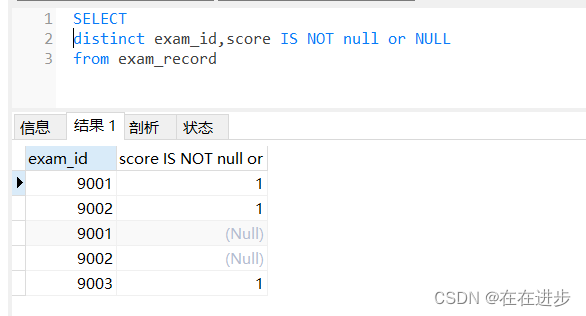
(3)结果应该是3,如果没有or NULL,就是5行了(null为0会被计数)
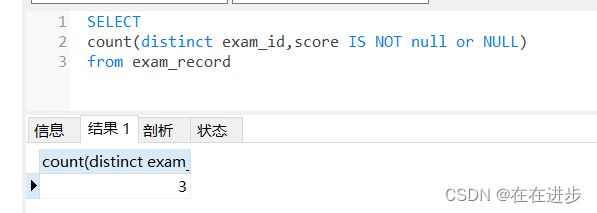
1.3 得分不小于平均分的最低分

我的代码:where后面的条件错了,但是思路大概这样。
select score min_score_over_avg
from exam_record er join examination_info ei
on er.id = ei.id
group by exam_id
where score>=avg(score) and ei.tag = 'SQL'
order by score asc
limit 1修改我的代码:
select er.score min_score_over_avg
from exam_record er
left join examination_info ei
on er.exam_id = ei.exam_id # 不是按照id连接
where ei.tag = 'SQL'
and score>= (SELECT avg(er.score) from exam_record er
left join examination_info ei
on er.exam_id=ei.exam_id
where ei.tag='SQL')
order by score asc
limit 1(1)表连接是按照exam_id ,不是按照id连接
(2)score>=某个值,这里不能直接score>=avg(score),而是应该通过表查询返回得到avg(score),然后在进行比较。
改进我的代码:
这里有表查询的部分重复了两次,可以用with...as句式将要多次使用的表命名,这样可以只写一次,多次调用。
此外,order by score asc limit 1 可以换为min函数。
with t as
(SELECT score from exam_record er
left join examination_info ei
on er.exam_id=ei.exam_id
where ei.tag='SQL')
select min(score) min_score_over_avg
from t
where score>=
(SELECT avg(t.score) from t)2 分组查询
2.1平均活跃天数和月活人数
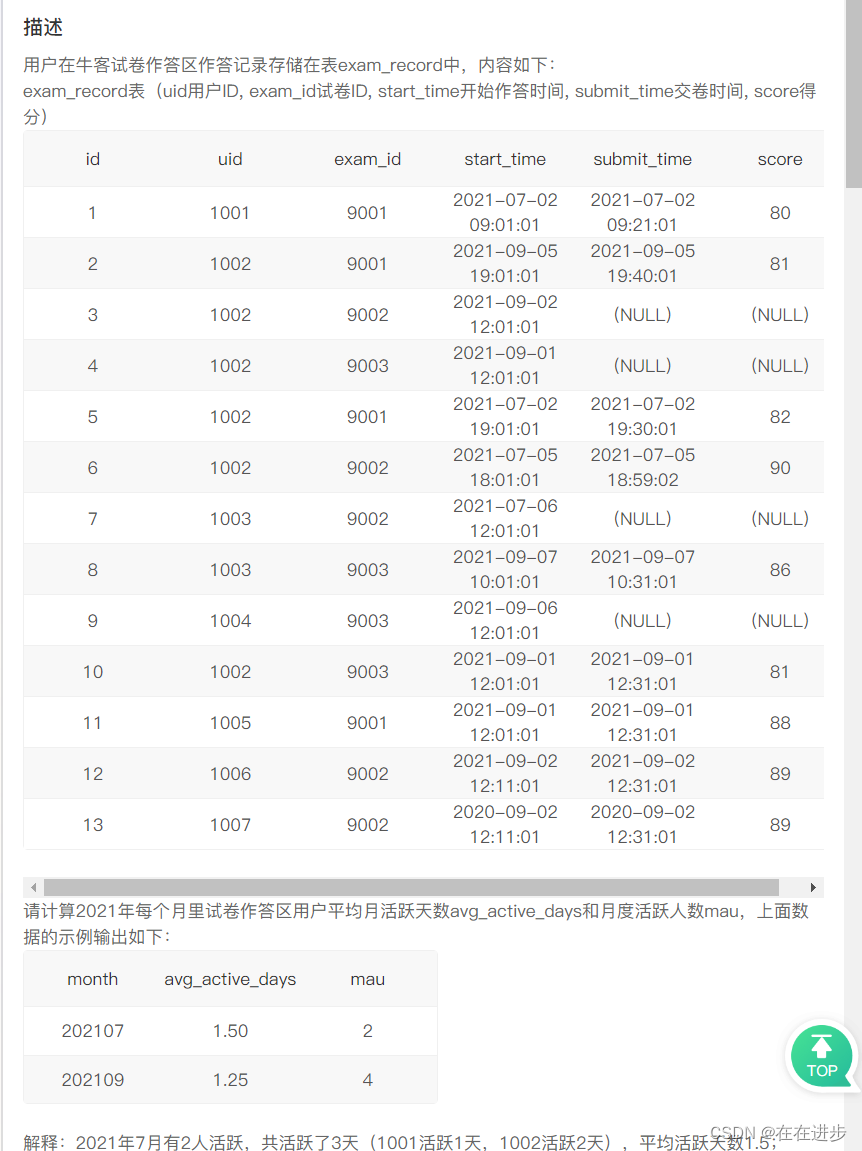
我的代码:此处活跃指有交卷行为,用户平均月活跃天数avg_active_days啥意思?
with t as
(select *
from exam_record
where year(start_time)=2021)
select month(start_time) 'month',
count(submit_time) mau
from t
group by month(submit_time)正确代码:
select DATE_FORMAT(start_time,"%Y%m") as month,
round(count(distinct uid,date_format(start_time,"%Y%m%d"))/count(distinct uid),2) as avg_active_days,
count(distinct uid) as mau
from exam_record
where submit_time is not NULL
and YEAR(submit_time) =2021
group by month;(1)202107是用date_format函数:DATE_FORMAT(start_time,"%Y%m") as month
(2)主要难的一点是天数的计算。
到底是count(distinct uid,date_format(start_time,"%Y%m%d"))
还是count(start_time)作为分子呢
关键是理解题目的意思是:天数。
假设一个uid 比如1001在2021-07-06这一天有二个记录,如果是count(start_time)那么就是天数是2,但是如果是count(distinct uid,date_format(start_time,"%Y%m%d"))天数就是1了
复盘探索:
(1)先找出2021年,活跃的用户ID和时间(具体到哪天)

(2)如果不考虑uid,直接按照活跃时间去重,那么不同用户在同一天活跃记录会被去重到只剩下1条,
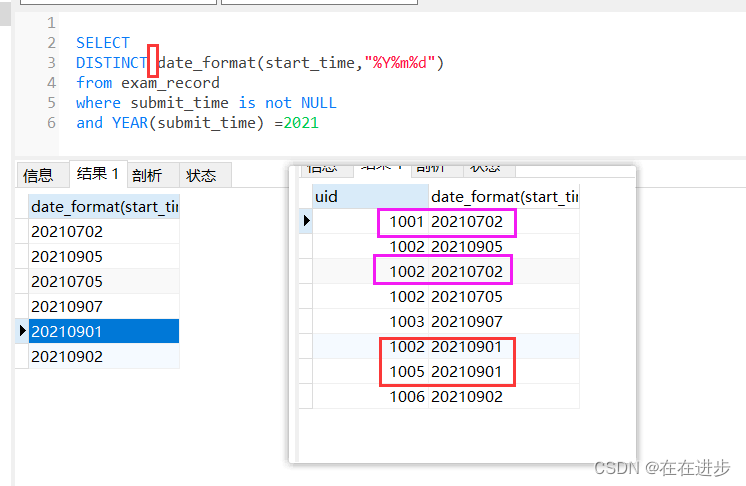
(3)同理,如果只安装用户ID去重,那么同一用户在不同天的记录也会被去重到只有1条。这里查询的实际是月活跃的用户有哪些。
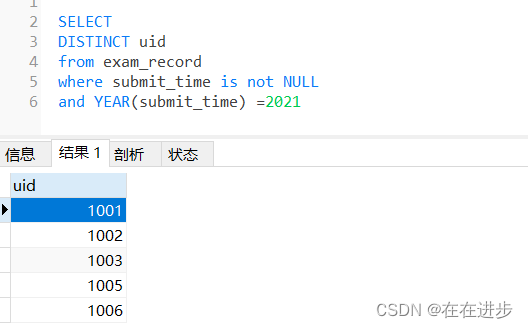
(4) 所以要去重的目的是,同一个用户,在同一天,重复提交活跃多次的记录。(因为这里是按天算,同一天同一个用户只算一次。)

(5)用户平均月活跃天数=月活跃天数 /月活跃用户
:count(distinct uid,date_format(start_time,"%Y%m%d"))/count(distinct uid)
月活跃天数:
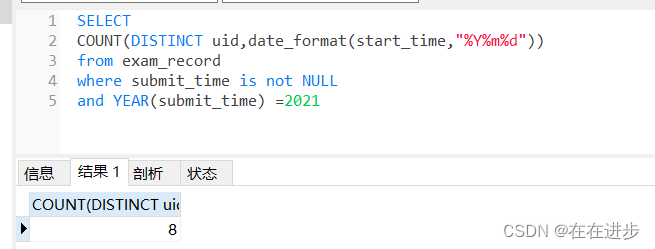
月活跃用户:
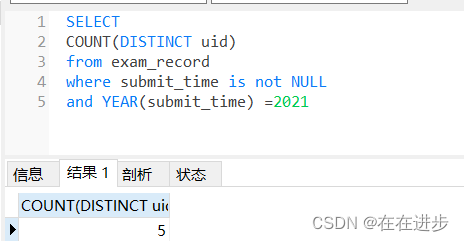
2.2 月总刷题数和日均刷题数
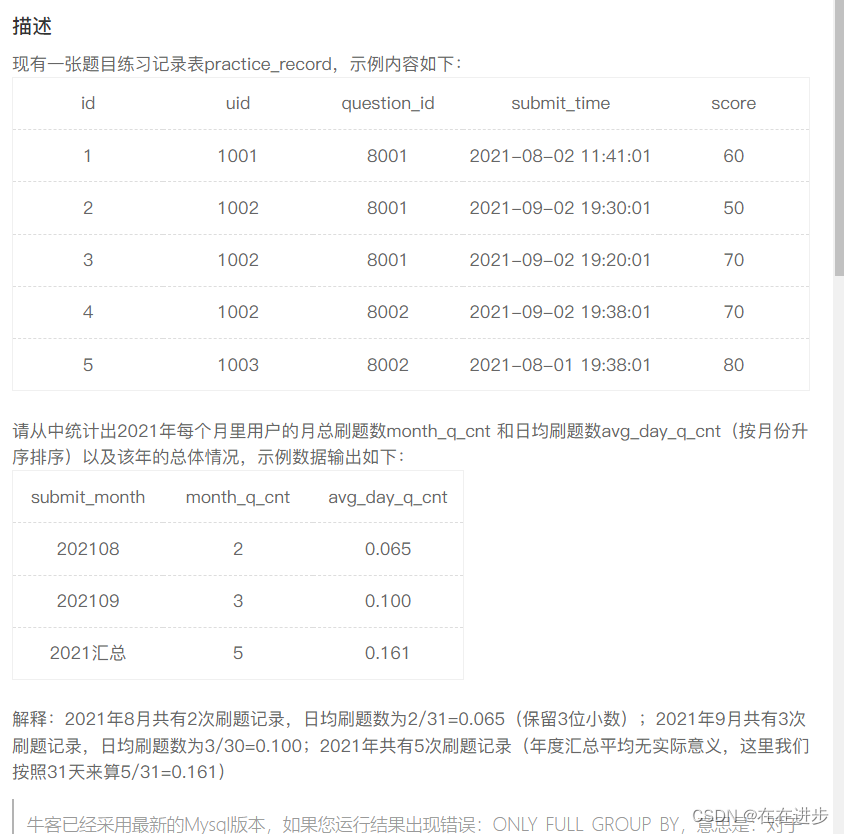
我的代码:分组好像报错,后面那个求总数我也不知道咋整
分组报错问题:MySQL提供了any_value()函数来抑制ONLY_FULL_GROUP_BY值被拒绝
select
date_format(submit_time,'%y%m') submit_month,
count(score) month_q_cnt,
count(score)/day(month(submit_time)) avg_day_q_cnt
from practice_record
group by date_format(submit_time,'%y%m%d')
having year(submit_time)=2021(1)当月天数求错了,我是想先求出当前月,再求出当月天:这样操作结果是不对的。

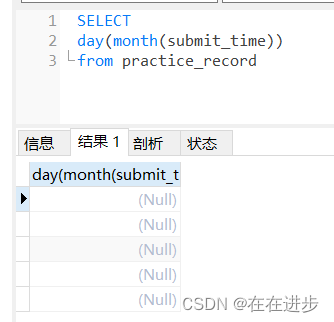
应该用last_day函数求出最后一天,然后用day函数求出这个日期的天数。

复习【日期时间函数】
● year(date)——获取年的函数
● month(date)——获取月的函数
● day(date)——获取日的函数
● date_add(date,interval expr type)——对指定起始时间进行加操作
● date_sub(date,interval expr type)——对指定起始时间进行减操作
● datediff(date1,date2)——计算两个日期之间间隔的天数
● date_format(date,format)——将日期和时间格式化
代码改正:
select
date_format(submit_time,'%y%m') submit_month,
any_value(count(score)) month_q_cnt,
any_value(round(count(score)/day(last_day(submit_time)),3)) avg_day_q_cnt
from practice_record
where year(submit_time)='2021'
# where date_format(submit_time,'%y')='2021'
group by submit_month
该年的总体情况,可以用union all来连接,完整代码:
select date_format(submit_time,'%Y%m') submit_month,
any_value(count(question_id)) month_q_cnt,
any_value(round(count(question_id)/day(LAST_DAY(submit_time)),3)) avg_day_q_cnt
from practice_record
where date_format(submit_time,'%Y')='2021'
group by submit_month
union all
select '2021汇总' as submit_month,
count(question_id) month_q_cnt,
round(count(id)/31,3) avg_day_q_cnt
from practice_record
where date_format(submit_time,'%Y')='2021'
order by submit_month;复习:
1、区别1:取结果的交集
1)union: 对两个结果集进行并集操作, 不包括重复行,相当于distinct, 同时进行默认规则的排序;
2)union all: 对两个结果集进行并集操作, 包括重复行, 即所有的结果全部显示, 不管是不是重复;
2、区别2:获取结果后的操作
1)union: 会对获取的结果进行排序操作
2)union all: 不会对获取的结果进行排序操作
3、总结
union all只是合并查询结果,并不会进行去重和排序操作,在没有去重的前提下,使用union all的执行效率要比union高。
2.3未完成试卷数大于1的有效用户
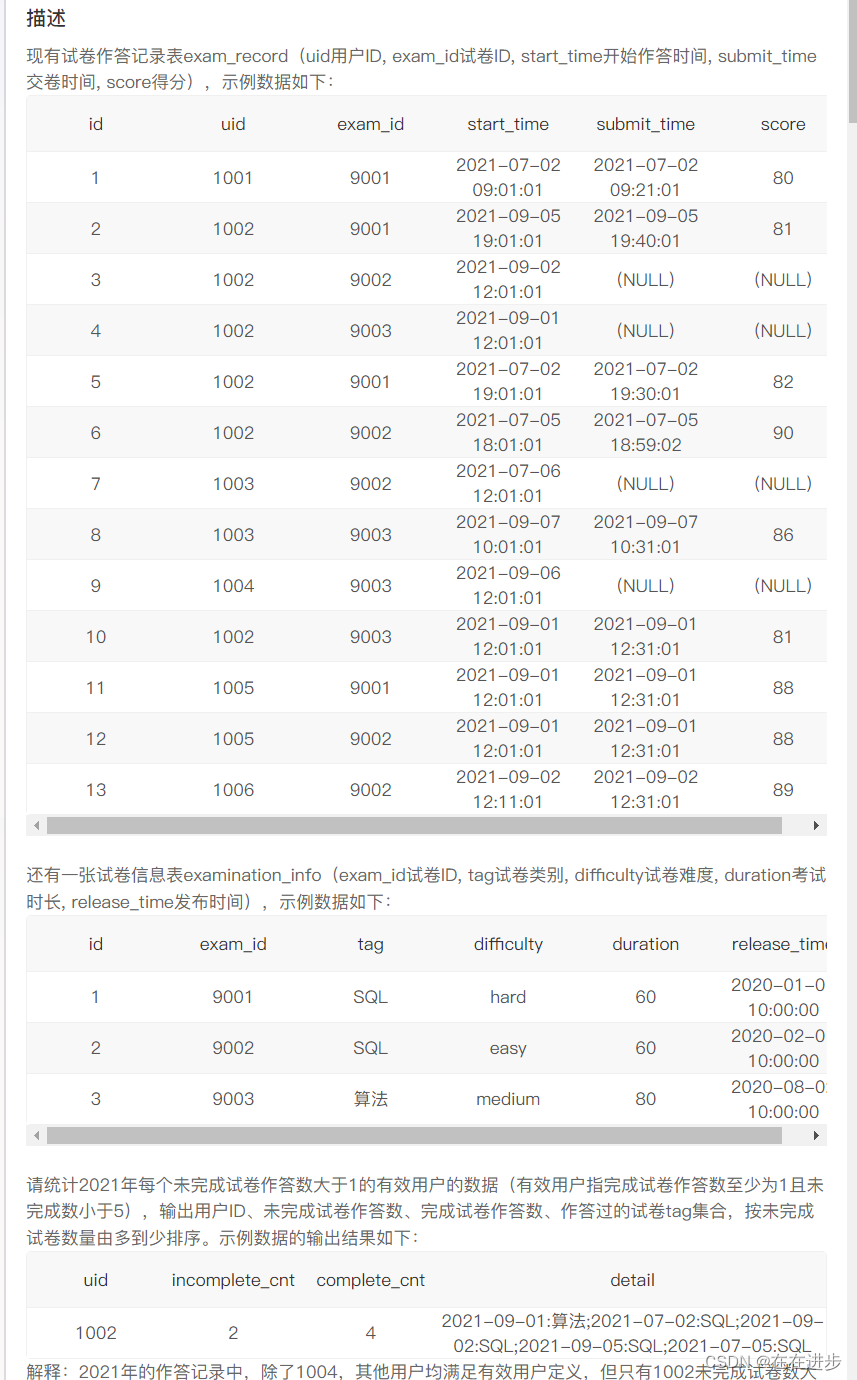
我的代码:罗里吧嗦答案还不对。。
with t as
(select uid,er.exam_id,start_time,submit_time,tag
from exam_record er , examination_info ei
where er.exam_id=ei.exam_id
and date_format(start_time,'%Y')='2021')
select uid,
(select count(submit_time) from t
where submit_time is NULL) incomplete_cnt,
(select count(submit_time) from t
where submit_time is not NULL) complete_cnt
from t
where (select count(submit_time) from t
where submit_time is NULL)<5
and (select count(submit_time) from t
where submit_time is not NULL)>1
order by incomplete_cnt我的代码改正:
select uid,
sum(case when submit_time is NULL then 1 else 0 end ) incomplete_cnt,
sum(case when submit_time is NULL then 0 else 1 end ) complete_cnt
from exam_record er join examination_info ei
on er.exam_id=ei.exam_id
where date_format(start_time,'%Y')='2021'
group by uid
having incomplete_cnt >1 and incomplete_cnt<5 and complete_cnt>1
order by incomplete_cnt接下来是detail,作答过的试卷tag集合,是提交日期:类型;一直重复显示
![]()
我的完整代码:
select uid,
sum(case when submit_time is NULL then 1 else 0 end ) incomplete_cnt,
sum(case when submit_time is NULL then 0 else 1 end ) complete_cnt,
group_concat(DISTINCT concat_ws(':',date_format(start_time,"%Y-%m-%d"),tag) order by start_time Separator ';') detail
from exam_record er join examination_info ei
on er.exam_id=ei.exam_id
where date_format(start_time,'%Y')='2021'
group by uid
having incomplete_cnt >1 and incomplete_cnt<5 and complete_cnt>1
order by incomplete_cnt desc注意:select后面的属性,不管计算了多长,每个之间都要有逗号!!!
大佬代码:
SELECT uid,
SUM(CASE WHEN submit_time IS NULL THEN 1 ELSE 0 END) "incomplete_cnt",
SUM(CASE WHEN submit_time IS NULL THEN 0 ELSE 1 END) "complete_cnt",
group_concat(distinct concat_ws(':',date(start_time),tag)
order by start_time separator ';') as detail
FROM exam_record er INNER JOIN
examination_info ei
ON er.exam_id = ei.exam_id
WHERE year(start_time) = 2021
GROUP BY uid
HAVING complete_cnt >= 1 AND incomplete_cnt > 1 AND
incomplete_cnt < 5
ORDER BY incomplete_cnt desc其中
(1)用sum和case when函数来求完成和未完成的试卷数
(2)detail的实现是用concat_ws或者concat函数将submit_time和tag连接并且同时distinct:
函数group_concat([DISTINCT] 要连接的字段 [Order BY ASC/DESC 排序字段] [Separator'分隔符'])
concat()函数
-
功能:将多个字符串连接成一个字符串。
-
语法:concat(str1, str2,…)
-
返回结果为连接参数产生的字符串,如果有任何一个参数为null,则返回值为null。
concat_ws()函数
- 功能:和concat()一样,将多个字符串连接成一个字符串,但是可以一次性指定分隔符(concat_ws就是concat with separator)
- 语法:concat_ws(separator, str1, str2, …)
- 说明:第一个参数指定分隔符。需要注意的是分隔符不能为null,如果为null,则返回结果为null。























 被折叠的 条评论
为什么被折叠?
被折叠的 条评论
为什么被折叠?








